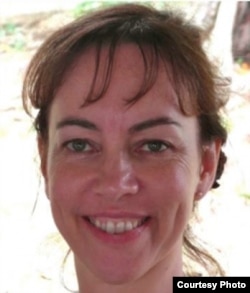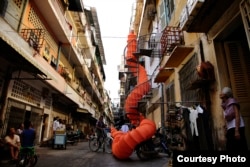Editor’s note: Cambodian performance artist Anida Yoeu Ali is a dynamic artist who possesses a unique worldview of the power of resilience, adaptability, and flexibility, says Kate Cary Evans, founder and editor-in-chief of Art Radar. Evans nominated Ali for the 11th Sovereign Asian Art Prize because of her unique artwork to combine many mediums and types, including performance art, installation, textile, video, and photography, into one piece. The flexibility of Ali’s artwork about Cambodia’s history of violence, erasure, and resilience can be universally understood, Evans recently told VOA Khmer.
Why did you nominate Anida Yoeu Ali for the Sovereign Asian Art Prize?
I founded a journal called Art Radar, which has been running since 2008. The team at Art Radar and I have been following Anida's work for years. We've written about her projects, residencies and also interviewed her about the Buddhist Bug project which is the artwork which won the Sovereign Prize.
One of the reasons that we nominated Anida is because the Sovereign Asian Art Prize is aimed at honoring the work of mid-career Asian artists who have something unique to say, and we think that Anida fits that definition.
Originally from Cambodia, she fled to the US at the height of the Khmer Rouge but moved back to Phnom Penh in 2011, which she has said is now a very exciting place to be an artist and really inspires her. We think her art has a fascinating tale to tell about how people respond to displacement, turmoil.
Another reason we selected Anida is that the prize has frequently been won by artists from Hong Kong, and only once by an artist from Southeast Asia (Thailand). At Art Radar, we know that there is some incredible work being produced right across Asia, but it is often overlooked. Art Radar's mission is to raise the profile of deserving artists which don’t get the attention they should. We think Anida is a talented and very deserving artist. We are thrilled for her.
What type of art does she make?
Anida is a really dynamic artist. She works in many mediums, and in the Buddhist Bug Project there are elements of performance art, installation, textile, video, and photography.
The Buddhist Bug, which won the prize, is actually inspired by a toy common in the West. It is a spiral tunnel which can be expanded so a child can climb inside it and then collapsed and put away after the child has finished. Her artwork looks and moves like a giant bug.
The Bug travels and is implanted into public places and becomes a platform for audience involvement and performances which are then documented in photos and video. Her work is so flexible - just like a real bug.
I think what is rare about Anida is that although many artists use multiple media, there are very few who are able to combine so many mediums and types into one piece. Artists often combine one or two or even three into an artwork for example they make an installation and then photograph it. Then they may go on to make another piece which combines other elements.
But it is the sheer breadth incorporated into one single art piece which took us by surprise. We love the way the Buddhist bug can be both public or private, experiential or documentary. It can be here or there, it can be big or small. It is for children and adults. It is a fascinating work.
What is distinctive about her work, especially within the contemporary Asian context?
Apart from the flexibility of her work, we think she has a unique worldview.
Much of her growing up and education was in the US, and then she rediscovered her Cambodian roots and history and moved back to Phnom Penh.
Her work is about Cambodia's history of violence, erasure and resilience. I think that her background has given her a unique perspective on the power of resilience, adaptability, flexibility in a way which could only have come from her experiences of being Cambodian.
However it is a message which resonates universally with people, especially young people, around the world today. For many reasons the world is changing faster and faster, especially due to technology. The universal question today is how do we adapt yet stay the same, how do we fit in yet preserve ourselves. The Buddhist Bug is a wonderful physical symbol of flexibility.
We also love her commitment to issues of resilience and community which can be seen in the several organizations she has co-founded, such as the women's dance collective Mango Tribe, the Asian American Artists Collective and the media art lab Studio Revolt, which works with local Cambodian youth and deported artists.










